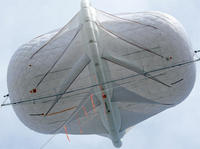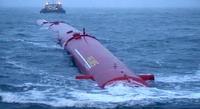-
U.S. energy policy should emphasize supply security, not energy independence
America’s policymakers need to consider whether energy independence is really necessary to achieve adequate, reliable and affordable energy supplies, according to a new report from Deloitte; the United States already enjoys significant energy independence for most sectors and much of our economy
-
-
U.S. keeps collecting money for a nuclear waste repository – but has no plans to build one
Illinois utility customers have paid the U.S government $1.9 billion to store spent nuclear fuel from nuclear plants in the state in a permanent national nuclear waste repository; in the last thirty years, the U.S. government has collected $30 billion from utilities toward this permanent storage, and it keeps collecting $750 million a year; trouble is, in February 2009 the Obama administration decided to “defund” the Yucca Mountain nuclear repository project, and the U.S. government no longer has active plans for a centralized nuclear waste storage facility
-
-
Innovative, “complete” solution for oil-spill cleanup
Corncobs, straw, and other absorbents used to clean up oil spills can hold only about five times their own weight and pick up water, as well as oil; scientists describe what may be a “complete solution” to cleaning up oil spills — a superabsorbent material that sops up forty times its own weight in oil and then can be shipped to an oil refinery and processed to recover the oil
-
-
Keystone XL pipeline: reliability of remote oil-spill sensors questioned
The oil industry plans to build thousands of miles of pipelines in the next five years, making leak detection a growing issue; many of the new pipelines will cross aquifers and rivers which are used for drinking water and irrigation; the Keystone XL pipeline has already experienced its share of controversies, and now there is a debate over the quality and reliability of the pipeline’s sensor system for remote detection of oil spills
-
-
Thermoelectric material converts heat waste to electricity

Scientists have developed a thermoelectric material which they claim is the best in the world at converting waste heat to electricity; this is very good news, since nearly two-thirds of energy input is lost as waste heat
-
-
U.S. models underestimates costs of carbon pollution
Model used by government all but ignores economic damages that climate change will inflict on future generations; two economists argue that when these costs are factored in, the real benefits of carbon reduction range from 2.6 to more than 12 times higher than the government’s estimate
-
-
At least 200,000 tons of oil, gas from Deepwater Horizon spill consumed by bacteria

Researchers have found that, over a period of five months following the disastrous 2010 Deepwater Horizon explosion and oil spill, naturally occurring bacteria which exist in the Gulf of Mexico consumed and removed at least 200,000 tons of oil and natural gas that spewed into the deep Gulf from the ruptured well head
-
-
The spring 2010 BP oil disaster could have been prevented: expert
The BP oil disaster in the Gulf of Mexico during the spring of 2010 could have been prevented if the experiences of earlier disasters had been put to use, an expert claims; the U.S. government is now accusing BP of gross negligence and deliberate misconduct, and taking the company to court
-
-
There is enough wind power to meet global energy demand

There is enough energy available in winds to meet all of the world’s demand; atmospheric turbines that convert steadier and faster high-altitude winds into energy could generate even more power than ground- and ocean-based units
-
-
Predicting waves’ height, force could double marine-based energy

In the search for alternative energy, scientists have focused on the sun and the wind; there is also tremendous potential in harnessing the power of the ocean’s waves, but marine energy presents specific challenges that have made it a less promising resource; one of these challenges is the fact that waves differ in terms of their size and force; forecasting wave height one second in advance optimizes energy collection
-
-
Innovative hydroelectric solution harvests power from water flowing through municipal pipes
An innovative solution has made it so dams do not have to be built in order to get hydroelectricity; hydroelectric power can now be harvested from water flowing through municipal pipes; the innovation is creating energy by using existing infrastructure, as well as solving a problem in that infrastructure
-
-
Engineers develop electricity-free home cooling system
Researchers are developing a solar cooling and heating system for the home which will run independently of the electricity grid and generate domestic hot water as a by-product
-
-
Mystery of dramatic leveling off of methane in the atmosphere solved

Increased capture of natural gas from oil fields probably accounts for up to 70 percent of the dramatic leveling off seen in atmospheric methane at the end of the twentieth century; methane has twenty times the global warming potential of carbon dioxide, although CO2 is filling the atmosphere in far larger amounts
-
-
Engineering students build U.K. first hydrogen powered locomotive
Engineering students and staff at the University of Birmingham have designed and built a prototype hydrogen powered locomotive, the first of its kind to operate in the United Kingdom
-
-
Future increases in U.S. natural gas exports may not be as large as thought

Amid policy debate over potential liquefied natural gas (LNG) exports from the United States, a new study predicts the long-term volume of exports from the United States will not likely be very large; the paper also argues that the impact on U.S. domestic natural gas prices will not be large if exports are allowed by the U.S government
-
More headlines
The long view
Trump Is Fast-Tracking New Coal Mines — Even When They Don’t Make Economic Sense
In Appalachian Tennessee, mines shut down and couldn’t pay their debts. Now a new one is opening under the guise of an “energy emergency.”
Smaller Nuclear Reactors Spark Renewed Interest in a Once-Shunned Energy Source
In the past two years, half the states have taken action to promote nuclear power, from creating nuclear task forces to integrating nuclear into long-term energy plans.
